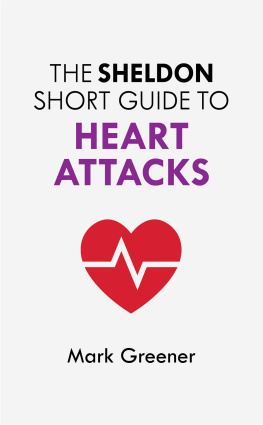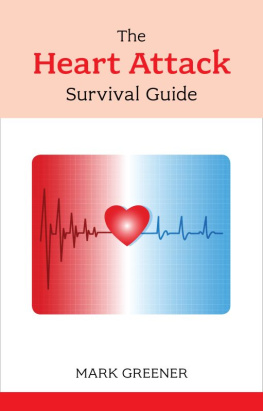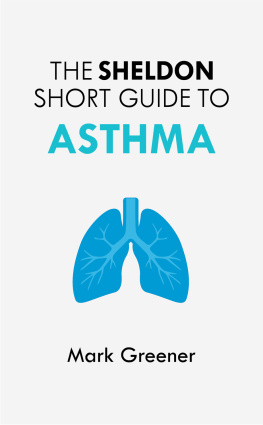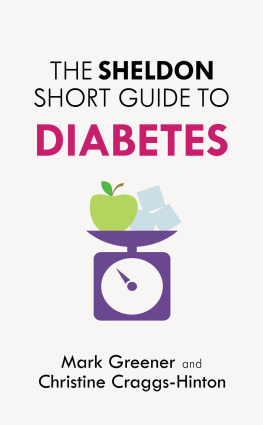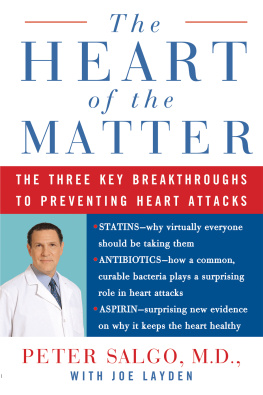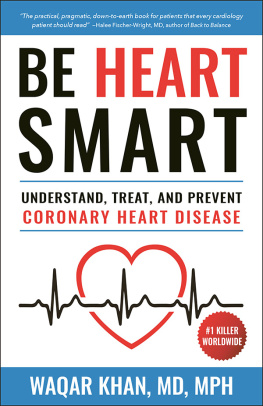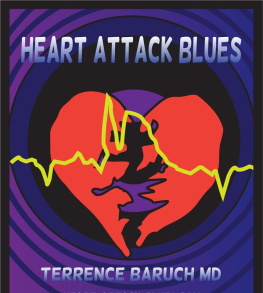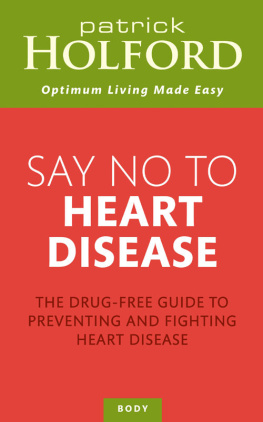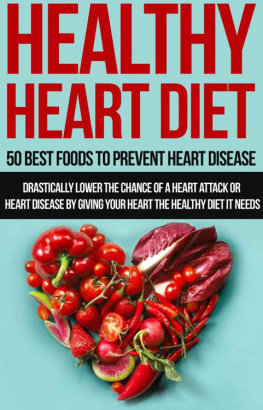The Sheldon Short Guide to
Heart Attacks
Mark Greener spent a decade in biomedical research before joining MIMS Magazine for GPs in 1989. Since then, he has written on health and biology for magazines worldwide for patients, healthcare professionals and scientists. He is a member of the Royal Society of Biology and is the author of 21 other books, including The Heart Attack Survival Guide (2012) and The Holistic Health Handbook (2013), both published by Sheldon Press. Mark lives with his wife, three children and two cats in a Cambridgeshire village.
Sheldon Short Guides
Asthma
Mark Greener
Depression
Dr Tim Cantopher
Diabetes
Mark Greener and Christine Craggs-Hinton
Heart Attacks
Mark Greener
Liver Disease
Mark Greener
Memory Problems
Dr Sallie Baxendale
Phobias and Panic
Professor Kevin Gournay
Stroke Recovery
Mark Greener
Worry and Anxiety
Dr Frank Tallis
THE SHELDON
SHORT GUIDE TO
HEART
ATTACKS
Mark Greener

This is not a medical book and is not intended to replace advice from your doctor. Consult your pharmacist or doctor if you believe you have any of the symptoms described, and if you think you might need medical help.
I used numerous medical and scientific papers to write the book that this Sheldon Short is based on: The Heart Attack Survival Guide . Unfortunately, there isnt space to include references in this short summary. You can find these in The Heart Attack Survival Guide, which discusses the topics in more detail. I updated some facts and figures for this book.
Every three minutes someone in the UK suffers a heart attack, according to the British Heart Foundation (BHF; ). Indeed, cardiovascular (heart and circulatory) disease kills about 160,000 people a year. While improved treatments and greater awareness of risk factors helped reduce deaths from heart disease over recent decades, millions of people in the UK are at risk of suffering their first myocardial infarction (MI), the medical term for a heart attack. Once you survive one heart attack, you may well face another. But you can reduce your risk even if youve developed angina, suffered an MI or are in your autumn years.
Almost anyone can suffer a heart attack. But some people are especially vulnerable. According to INTERHEART, a worldwide investigation into MI risk factors:
People with diabetes who smoke and have hypertension (dangerously raised blood pressure) are 13 times more likely to suffer an MI than those without any of these three risk factors.
Add a harmful profile of fat in your blood and obesity to these three risk factors and youre almost 69 times more likely to have a heart attack.
Suffer psychosocial problems (such as severe stress at home or work, or depression) in addition to the five other risk factors and you are 334 times more likely to suffer a heart attack than those without any of these risk factors.
Following the advice in this book and that offered by your doctor, nurse or pharmacist can dramatically improve your hearts health, even if youve suffered a heart attack or unstable angina which is a dangerous first cousin to MI. An MI doesnt need to break your heart.
The average healthy heart is about the size of your fist, weighs around 0.3 kilograms (10 ounces) and pumps blood along 60,000 miles of vessels. Incredibly, if you laid your blood vessels end to end theyd go around the equator almost two and a half times. At rest, a healthy heart typically pumps 60 to 80 times a minute moving about 11,000 litres (2,500 gallons) of blood a day. Blood vessels form two circulatory systems that begin and end at the heart ():
The pulmonary circulation connects your heart to your lungs.
The systemic circulation connects your heart to all other parts of your body.
The hearts four chambers two atria and two ventricles () beat in sequence, pushing blood around the circulation:
Systole refers to the contraction of the hearts chambers.
Diastole is the relaxation between beats, when the chambers fill with blood.
So, doctors and nurses record systolic and diastolic blood pressure.
The atria collect blood from the circulation and, when they contract, push blood into the ventricles, helping the larger chambers work effectively. The right atrium and right ventricle pump blood to the lungs. The left atrium and left ventricle pump blood to the rest of the body. So, the left ventricle is larger. Seven in every ten heart attacks occur in the left ventricle.
Controlling the flow
Heart valves ensure correct blood flow ():
Tricuspid valves control blood flow between the right atrium and right ventricle.
Bicuspid (mitral) valves control blood flow between the left atrium and left ventricle.
Semilunar valves prevent blood in the arteries from flowing back into the ventricles.
Early in diastole, the bicuspid and the tricuspid valves (together called the atrioventricular valves) open. Blood drains into the ventricles. After the ventricles are about three-quarters full, the atria contract. This forces the rest of the blood into the ventricles.
As the heart contracts, the bicuspid and tricuspid valves close to stop the pressure from forcing blood into the atria. As the pressure increases further, the semilunar valves (sometimes called the pulmonary valve and the aortic valve) open. Blood flows into two large blood vessels: the pulmonary artery and the aorta. The semilunar valves close at the beginning of diastole, which prevents blood from flowing back into the ventricles.
Controlling the beat
A pacemaker the sinoatrial node generates the hearts rhythm. Nerves and some chemical messages (e.g. hormones) fine tune the rhythm to meet your bodys needs. The sinoatrial node generates a pulse of electricity that spreads through the muscle to ensure that the heart contracts in sequence (). Doctors measure this wave using an electrocardiogram (ECG).
The circulatory system
Blood from the body, rich in carbon dioxide, enters the right atrium through two large veins: the superior vena cava and the inferior vena cava (). The right atrium pumps blood into the right ventricle. When the heart contracts, blood flows from the right ventricle into the pulmonary artery, which splits into two to supply each lung. Carbon dioxide moves from the blood into the lungs and is expelled when we breathe out. Meanwhile, oxygen in the air weve breathed in attaches to an iron-rich protein (haemoglobin) in red blood cells (erythrocytes). Oxygen-rich blood travels to the left atrium.
Arteries, veins and capillaries
Arteries carry blood from the heart and branch into medium-sized and then small arteries (arterioles). These arterioles divide into microscopic capillaries. These tiny vessels have thin walls that allow oxygen and nutrients to move from the blood into the tissue. Meanwhile, blood in the capillaries absorbs carbon dioxide and other waste products. (In the lung, oxygen moves into the capillaries, while carbon dioxide moves out.) Capillaries merge, forming venules and, in turn, veins that return blood to the heart. Most arteries carry oxygen-rich blood. Most veins carry oxygen-depleted blood. However, pulmonary arteries carry oxygen-poor blood from your heart to your lungs. Pulmonary veins return oxygen-rich blood.
The left ventricle pumps blood into the ascending aorta (). From here, the blood takes one of four routes:
Coronary arteries supply the heart (cardiac) muscle with oxygen and nutrients. Angina () occurs when the hearts demand for oxygen outstrips the supply. Most heart attacks occur when a blockage in the coronary circulation stops blood flow.
Carotid arteries carry blood along the neck to the brains cerebral circulation.
Next page
